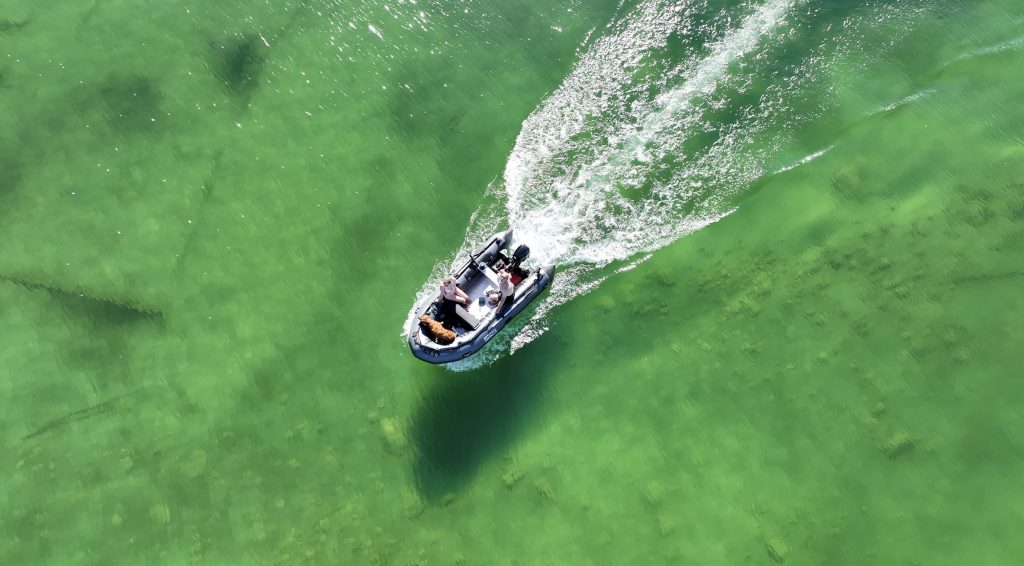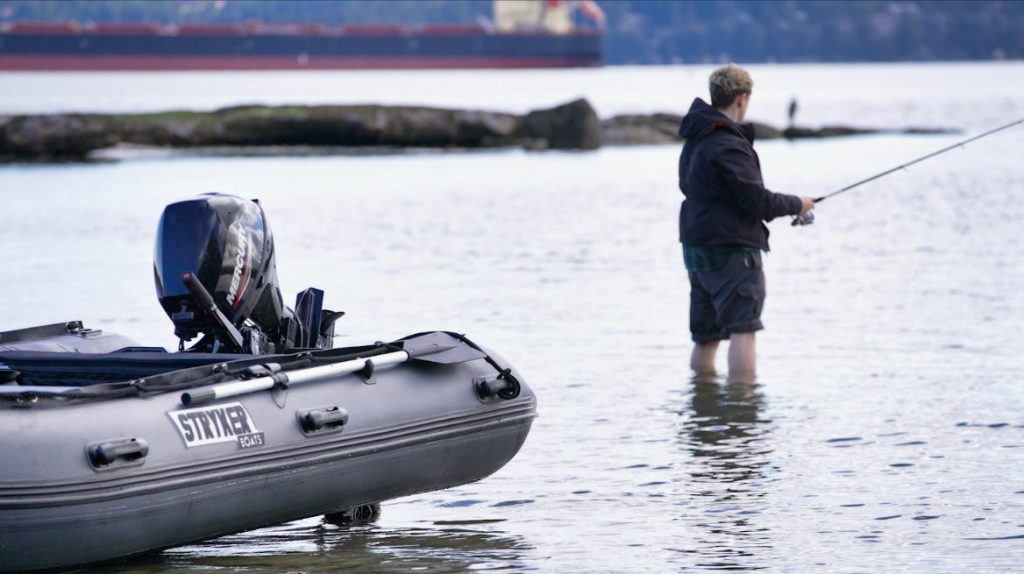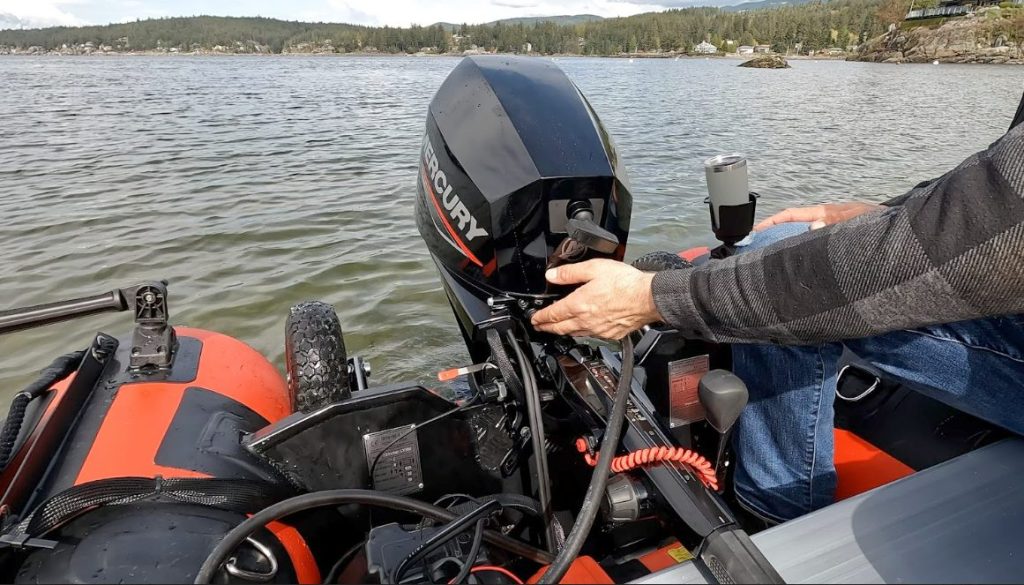Types of Outboard Motors for Inflatable Boats

- strykerboats@gmail.com
Inflatable boats are the popular choice for recreational boaters, fishermen, hunters, and rescue teams. One of the most essential components of an inflatable boat is the outboard motor.
Inflate your boat, deflate your worries, and let the motor do the rest!
The right motor can provide speed, power, and maneuverability, all traits that can make your boating experience more pleasurable and efficient.
Many motors are available for inflatable boats, each with unique characteristics, advantages, and disadvantages. This article will explore those and help you choose the best motor for your inflatable boat.
Types of inflatable boat motors:
There are four main types of inflatable boat motors:
Electric Motors
Electric outboard motors are great for those who value quiet, eco-friendly boating and fishing experiences. However, they may not be ideal for those who need to travel long distances or operate in rough waters, as they have limited battery life and may not be as powerful as gas outboard motors. They are also popular in environmentally sensitive areas where gasoline or diesel engines are restricted, and noise pollution is a concern.
Advantages:
Electric outboard motors are powered by electricity instead of fuel. They provide instantaneous power, which allows you to adjust your speed without delay easily. Their usage makes less noise when compared to gas powered motors, and their quiet operation makes them ideal for fishing, nature observation, and other activities where a peaceful environment is desired. They don’t leave an oil slick behind or produce no exhaust gasses or fumes, which makes them environmentally friendly and a healthier option for passengers to be around. They are often effortless to maintain and less likely to face wear and tear.
Disadvantages:
They are generally less powerful than gasoline engines and are only sometimes suitable for larger boats or rough water conditions. They also require a power source for recharging, which may not be available in remote or off-grid locations.
Uses:
Electric outboard motors are commonly used for small inflatable boats, dinghies, and other watercraft for leisure activities such as fishing or cruising.

2. Gas motors
Gasoline outboard motors are the most common type of inflatable boat motor. They use an engine, gearbox, propeller, or jet drive to propel the boat forward. Overall, outboard gasoline motors are an excellent option for those needing power and speed for boating adventures.
Advantages:
These motors are very powerful. The size ranges from 2.5 to 300 horsepower, with larger motors providing more power. They can operate longer than electric motors, allowing you to travel greater distances. Gasoline outboard motors are also typically faster than electric motors, making them a better option for those who want to cover longer distances in shorter durations.
Disadvantages:
They are louder and produce more exhaust fumes than electric motors, which can concern those who prefer an eco-friendly boating experience. Additionally, they require regular maintenance, including changing the oil and checking the fuel filter and spark plugs to maintain longetitvity
Uses:
They are often used for a wide range of water activities like wakeboarding, tubing, and water skiing. Another advantage of gasoline outboard motors is their range.
3. Propane outboard motors
Propane outboard motors are gaining popularity. These motors use propane gas, which has several advantages over gasoline.
Advantages:
Propane is a cleaner burning fuel than gasoline. So, using it produces fewer harmful emissions and reduces the carbon footprint of boating. They cause less noise and vibration, which improves the boating experience. They are also safer to handle and store than gasoline motors as they are stored in pressurized tanks, which can be easily transported and refueled without spills. Propane is also less flammable than gasoline, reducing the fire risk.
Disadvantages:
They are less powerful than gasoline motors and may not be suitable for larger boats or rough water conditions. Propane is also less readily available than gasoline, so refueling may require more planning and preparation.
Uses:
Propane outboard motors are commonly used for small to medium-sized boats, including inflatable, fishing, and pontoon boats. They are ideal for recreational boating activities such as fishing, cruising, and sightseeing.
4. Jet propulsion systems
Jet propulsion systems are another alternative to traditional outboard motors for inflatable boats. Unlike propeller-driven motors, jet propulsion systems use a water jet to propel the boat forward.
Advantages
Unlike propeller-driven motors, jet propulsion systems do not have exposed propellers, which can pose a safety risk to swimmers or marine life. They also have a smaller carbon footprint than traditional outboard motors. Jet propulsion systems are known for their maneuverability and agility mainly because it allows for shallow water operation, as the water intake is beneath the boat’s hull.
Disadvantages:
They can be less fuel-efficient than propeller-driven motors, resulting in higher fuel costs over time. They are often expensive to repair and maintain.
Uses:
Jet propulsion systems are commonly used for various watercraft, including inflatable boats, personal watercraft, and small to medium-sized boats. They allow quick acceleration and high-speed handling, making them ideal for wakeboarding, skiing, fishing, and cruising.
What to choose & where to buy?
At Stryker Boats, we understand the importance of offering our customers a range of high-quality outboard motors. That’s why we have carefully selected three of the top brands in the industry – Tohatsu, Suzuki, and Mercury – to offer our customers.
- Tohatsu outboard motors are the world’s oldest and first manufacturer of outboards. Their motors are designed to operate longer, even in harsh conditions. They are also environmentally friendly with low emissions and have a five-year warranty.

- Suzuki outboard motors are known for their advanced designs and technology. They are lightweight and come with a six-year warranty. Maintenance is relatively cheap and easy, and they have low emissions.

- Mercury outboard motors have been providing dependable performance for over 70 years. They offer a range of options for all sizes of Stryker boats, and they come with up to eight years of warranty. They are the trusted choice of marine industry professionals and are known for their low emissions, fuel consumption, reliability, and value.

No matter which brands you choose, you can rest assured that you’re getting a top-quality outboard motor to power your Stryker boat.
Are you ‘propelled’ towards a great day on the water but still confused? Head over to our YouTube channel and understand more. Or, simply get in touch!


